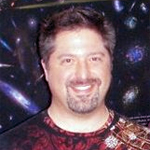Guest Post: A Comet is Coming!
by Mike Brotherton
 OK, there are often faint comets visible to a small telescope if you know where to look, but the bright, naked eye comets are rare. Hale-Bopp was a great one back in the late 1990s — already about 15 years ago. Crap, it seems like yesterday to me how normal it was to look up in the sky and see that guy.
OK, there are often faint comets visible to a small telescope if you know where to look, but the bright, naked eye comets are rare. Hale-Bopp was a great one back in the late 1990s — already about 15 years ago. Crap, it seems like yesterday to me how normal it was to look up in the sky and see that guy.
Now when I talk about comets in my introductory astronomy classes, and ask who has seen a comet (Hale-Bopp being the likely candidate), almost no one raises their hand. They were little kids back then.
But there’s a promising new comet candidate that could rival the moon in brightness and be visible in the day time sky late in 2013. (Heh, winter is coming, there’s a comet…so where are my dragons?)
It could fizzle — it’s hard to predict — but it seems unlikely to fizzle much. It’s going to be pretty good, I think, given it’s orbit that suggests it’s likely close to primordial. But…
In a guest blog for the Planetary Society, astronomer Bill Gray agrees, pointing out that Comet ISON’s orbit has been very well constrained, but just how bright the comet will become is anyone’s guess:
“…estimating comet brightnesses a year ahead of time is about like asking who’s going to win the World Series next year,” writes Gray. “It could be astonishingly bright, or it could fizzle. I think it was David Levy (co-discoverer of Comet Shoemaker–Levy 9) who said that comets are like cats: they have tails, and do whatever they want to do.”
•••
 Originally from the St. Louis area, Mike Brotherton got his PhD in astronomy from the University of Texas in 1996, and held positions at Lawrence Livermore National Laboratory and Kitt Peak National Observatory before coming to Laramie. His specialty is studying the supermassive black holes in the centers of galaxies and how they shine when in the active phase. He is also interested in the relationship between such active galactic nuclei (AGN) and their host galaxies, and their mutual evolution. His work is primarily observational, and he uses a wide assortment of telescopes/observatories operating across the electromagnetic spectrum including WIRO, McDonald, IRTF, KPNO, Lick, Keck, Gemini, the VLT, Hubble, Chandra, and the VLA. He also makes use of data archives such as the Sloan Digital Sky Survey. In addition to being a scientist, he is a science fiction writer, author of the well-received science fiction novels Star Dragon (2003) and Spider Star (2008) from Tor Books. He is also the founder of the NASA-funded Launch Pad Astronomy Workshop for Writers, which brings a dozen award-winning professional writers to Wyoming every summer. He blogs at www.mikebrotherton.com where this post first appeared.
Originally from the St. Louis area, Mike Brotherton got his PhD in astronomy from the University of Texas in 1996, and held positions at Lawrence Livermore National Laboratory and Kitt Peak National Observatory before coming to Laramie. His specialty is studying the supermassive black holes in the centers of galaxies and how they shine when in the active phase. He is also interested in the relationship between such active galactic nuclei (AGN) and their host galaxies, and their mutual evolution. His work is primarily observational, and he uses a wide assortment of telescopes/observatories operating across the electromagnetic spectrum including WIRO, McDonald, IRTF, KPNO, Lick, Keck, Gemini, the VLT, Hubble, Chandra, and the VLA. He also makes use of data archives such as the Sloan Digital Sky Survey. In addition to being a scientist, he is a science fiction writer, author of the well-received science fiction novels Star Dragon (2003) and Spider Star (2008) from Tor Books. He is also the founder of the NASA-funded Launch Pad Astronomy Workshop for Writers, which brings a dozen award-winning professional writers to Wyoming every summer. He blogs at www.mikebrotherton.com where this post first appeared.


